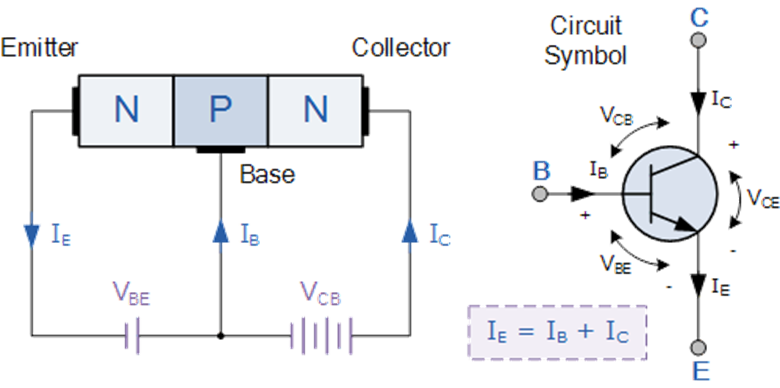
In NPN transistors, ${{10}^{10}}$ electrons enter the emitter region in ${{10}^{-6}}s$. If 2% electrons are lost in base region then collector current and current amplification factor (β) respectively are
$\begin{align}
& A.1.57mA,49 \\
& B.1.92mA,70 \\
& C.2mA,25 \\
& D.2.25mA,100 \\
\end{align}$
Answer
512.4k+ views
Hint: First of all find out the emitter current. After that find out the collector current using the formula
${{I}_{c}}=\alpha {{I}_{e}}$
$\alpha $ is given by how much current from the emitter reaches the collector. So using this $\alpha $ amplification factor can be found out.
Complete step by step answer:
Current amplification factor in a bi junction transistor is described as the ratio of output current to its input current. In the common base configuration, current amplification factor is given as the ratio of collector current to the emitter current. The low current travels from the voltage source into the transistor base. The current at the base will turn on the transistor. Then the current is amplified and travels from the emitter of the transistor to the collector. This is how current amplification takes place in a bi junction transistor. The amplifier is a very complex circuit which is using properties of a transistor.
Here let us first write what all are given in the question.
Number of electrons entering emitter,
${{n}_{e}}={{10}^{10}}$
Time taken=${{10}^{-6}}s$
Therefore the current in the emitter is
${{I}_{e}}=\dfrac{{{q}_{e}}\times {{n}_{e}}}{t}$
${{I}_{e}}=\dfrac{{{10}^{10}}\times 1.6\times {{10}^{-19}}}{{{10}^{-6}}}$
$=1.6mA$
Since only 2% current is lost, therefore 98% will reach the collector
So
\[\alpha =0.98\]
And also we know that
${{I}_{c}}=\alpha {{I}_{e}}$
Therefore the collector current will be,
\[\begin{align}
& =\alpha \times {{I}_{e}} \\
& =0.98\times 1.6 \\
& {{I}_{c}}\approx 1.57mA \\
\end{align}\]
Also the current amplification factor will be,
\[\beta =\dfrac{\alpha }{1-\alpha }=49\]
Hence the correct answer is given by the option A.

Note:
MOSFETs are controlled by voltage not on their own. It is used to amplify current using a MOSFET by passing the input current through a resistor there by converting the current signal to a voltage. This signal voltage is controlling the MOSFET, which gives an output signal current.
${{I}_{c}}=\alpha {{I}_{e}}$
$\alpha $ is given by how much current from the emitter reaches the collector. So using this $\alpha $ amplification factor can be found out.
Complete step by step answer:
Current amplification factor in a bi junction transistor is described as the ratio of output current to its input current. In the common base configuration, current amplification factor is given as the ratio of collector current to the emitter current. The low current travels from the voltage source into the transistor base. The current at the base will turn on the transistor. Then the current is amplified and travels from the emitter of the transistor to the collector. This is how current amplification takes place in a bi junction transistor. The amplifier is a very complex circuit which is using properties of a transistor.
Here let us first write what all are given in the question.
Number of electrons entering emitter,
${{n}_{e}}={{10}^{10}}$
Time taken=${{10}^{-6}}s$
Therefore the current in the emitter is
${{I}_{e}}=\dfrac{{{q}_{e}}\times {{n}_{e}}}{t}$
${{I}_{e}}=\dfrac{{{10}^{10}}\times 1.6\times {{10}^{-19}}}{{{10}^{-6}}}$
$=1.6mA$
Since only 2% current is lost, therefore 98% will reach the collector
So
\[\alpha =0.98\]
And also we know that
${{I}_{c}}=\alpha {{I}_{e}}$
Therefore the collector current will be,
\[\begin{align}
& =\alpha \times {{I}_{e}} \\
& =0.98\times 1.6 \\
& {{I}_{c}}\approx 1.57mA \\
\end{align}\]
Also the current amplification factor will be,
\[\beta =\dfrac{\alpha }{1-\alpha }=49\]
Hence the correct answer is given by the option A.

Note:
MOSFETs are controlled by voltage not on their own. It is used to amplify current using a MOSFET by passing the input current through a resistor there by converting the current signal to a voltage. This signal voltage is controlling the MOSFET, which gives an output signal current.
Recently Updated Pages
Master Class 12 Biology: Engaging Questions & Answers for Success

Class 12 Question and Answer - Your Ultimate Solutions Guide

Master Class 12 Business Studies: Engaging Questions & Answers for Success

Master Class 12 Economics: Engaging Questions & Answers for Success

Master Class 12 Social Science: Engaging Questions & Answers for Success

Master Class 12 English: Engaging Questions & Answers for Success

Trending doubts
Father of Indian ecology is a Prof R Misra b GS Puri class 12 biology CBSE

Who is considered as the Father of Ecology in India class 12 biology CBSE

Enzymes with heme as prosthetic group are a Catalase class 12 biology CBSE

A deep narrow valley with steep sides formed as a result class 12 biology CBSE

An example of ex situ conservation is a Sacred grove class 12 biology CBSE

Why is insulin not administered orally to a diabetic class 12 biology CBSE




